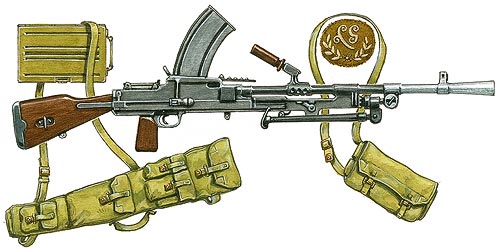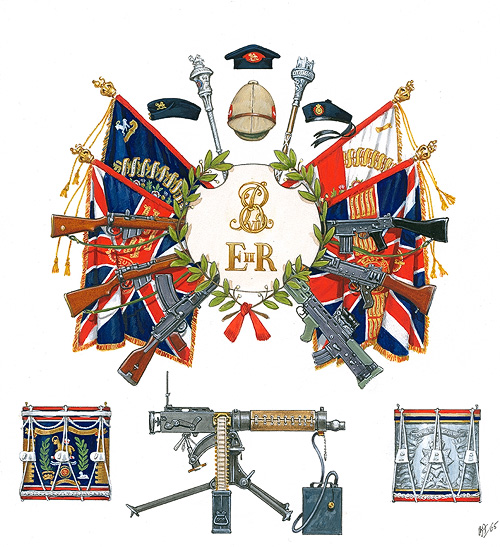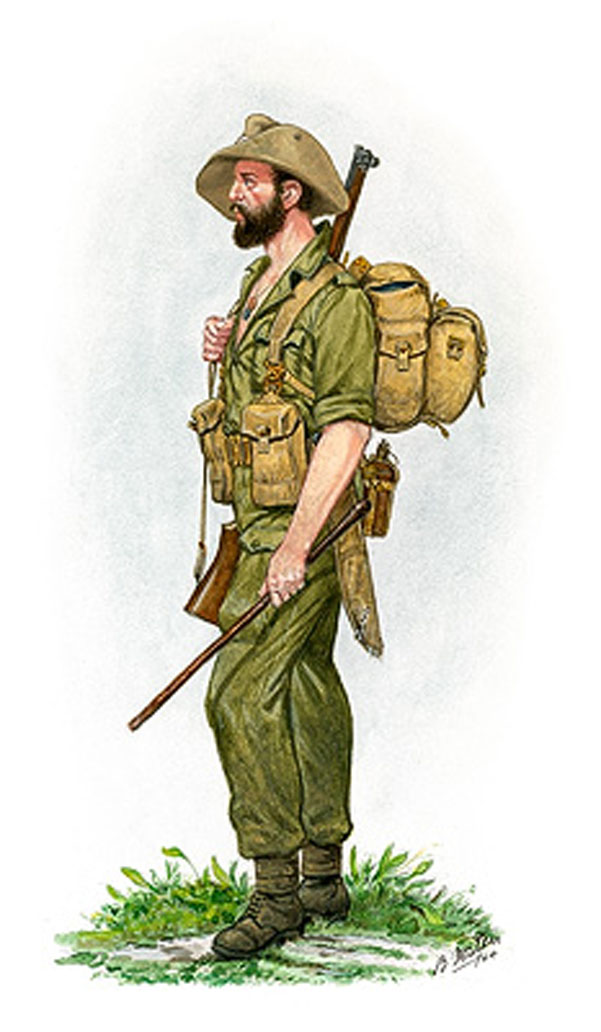 The Queen's in the Second World War
The Queen's in the Second World War
The Regular Battalions in the 1939-1945 War
After 12 years in England the 2nd Battalion had been sent to Palestine in 1939 and was engaged in security operations when the 2nd World War began. The 1st Battalion was in Allahabad in India, and so it was the Territorial Battalions which made the first contact with the enemy in Europe.
The 1st Battalion spent the war in the Far East. For over a year from October 1940, it was deployed on the North-West Frontier in operations against the tribes and then in 1942 it joined the 7th Indian Division. The Division was deployed in the Arakan in Burma in September 1943 and the Battalion saw some hard fighting through the winter months inflicting the first reverses on the Japanese. In May 1944 the Battalion was flown up to Kohima to help relieve the gallant 4th Queen's Own Royal West Kents who were holding out alone against the main Japanese attempt to invade India. In the battle for Jail Hill, Kohima, the 1st Battalion played a major part in bringing about the defeat of the Japanese. This action was considered the turning point of the War in Burma: thereafter the Japanese were always in retreat. Later in 1945 the Battalion drove the enemy down the Irrawaddy River and fought its last battle of the war north of Rangoon at the end of July. In the war against the Japanese this Battalion never failed to take its objectives and was never made to withdraw from ground it had won.
The 2nd Battalion, initially in the Middle East, took part in General Wavell's successful campaign in the Western Desert in 1940, including the capture of Sidi Barrani. In 1941 after two abortive efforts to reach Crete while the German invasion was in progress, it took part in the war in Syria against the Vichy French. in September it was landed by sea at Tobruk with the 70th Division to relieve the Australian garrison, and then in November 1941, it took part in the successful break out against General Rommel's forces and linked up with the 8th Army offensive.
| A Chindit of 2nd Queen's Royal Regiment. (Click to enlarge) |
Consequent upon the loss of Singapore in 1942, the 70th Division was moved to reinforce the Far East, initially the 2nd Battalion going to Ceylon and then to India, where in 1943 it became part of the Deep Penetration Forces (the Chindits) under General Wingate. The Battalion was divided into two columns, and with the rest of 16 Brigade marched under appalling conditions from the Ledo Road in the north to the centre of Burma using mule transport and re-supply by air. It finally took part in the operations in the Indaw area to disrupt the Japanese lines of communication. At the conclusion of these operations a long period to recover from the debilitating effects was required. After re-forming, the 2nd Battalion was training for the attack on Malaya (Operation Zipper), when the Japanese surrendered in August 1945.
The Territorial Battalions in the 1939-45 War
44 Home Counties Division which included 131 Queen's Brigade, 1st/5th, 1st/6th and 1st/7th Battalions, went to France on 3rd April 1940. They were followed later in the month by 35 Brigade which included 2nd/5th, 2nd/6th and 2nd/7th Battalions. The Germans launched their 'Blitzkrieg' on 10th May, 131 Brigade, after some heavy fighting on the Escaut and near La Bassée, carried out a fighting withdrawal through Dunkirk. The Naval Commander-in-Chief wrote that 'the bearing, good order and discipline of the Queen's was an example and inspiration to all of us in the Royal Navy'. 35 Brigade which was only half trained and half equipped, with no proper anti-tank weapons and no artillery, was evacuated through Cherbourg after being overrun by the main German armoured thrust. Its position had been hopeless from the start and the fact that the battalions came home, largely intact, is a lasting tribute to the spirit of The Queen's.

Formation signs worn by the battalions of the Regiment during the Second World War.
After Dunkirk in the reorganisation of the Army, 35 Brigade became 169 Queen's Brigade of 56 London Division and for two years took part in the defence of the Kent and Sussex Coasts. In the summer of 1942 both 44th and 56 Divisions were ordered overseas to the Middle East, where the former joined the 8th Army in North Africa, while 56 Division was deployed in north Iraq. In Egypt, 131 Brigade tenaciously held the Alam Halfa ridge area in the defeat of the main German offensive against the El Alamein position. Subsequently it fought, but at some cost, on the southern front at El Alamein. After this battle, 44 Division was broken up and the Brigade became the Lorried Infantry Brigade of 7th Armoured Division (The Desert Rats).

131 Brigade led the advance of the 8th Army from Tripoli to the Mareth Line where at Medenine the Germans mounted a counter attack using two Panzer Divisions; the three Queen's battalions, unprotected by mines and wire met the brunt of the attack and thoroughly defeated it. At dawn on 7th March 1943 there were no less than 27 tanks destroyed by their 6-pounder anti-tank guns in front of 1/7 Queen's. Following the battles of Mareth and Enfidaville, 1/7 Queen's was the first to enter Tunis.

Bren Gun and accessories.
Meanwhile 169 Brigade spent the winter of 1942/43 in Iraq, and when ordered to join the 8th Army, drove straight from Iraq into action at Enfidaville on 28th April. its approach march of 3,313 miles in 31 days, an average of 107 miles a day, is the longest in military history.


Both Queen's Brigades took part in the landings at Salerno, 169 Brigade in the initial assault force and 131 Brigade landing later with the follow up force. There was much hard fighting and when the break-out was made, the two Brigades led their Divisions, now in the 5th (US) Army, side by side across the plain of Naples, across the Volturno and beyond. 131 Brigade with 7th Armoured Division then returned to England in December 1943 to take part in the Normandy invasion. 169 Brigade in Italy fought on, capturing Monte Camino, crossing the Garigliano and finally were at Anzio, before returning in a very reduced state to Egypt to reform and retrain.
In 1944 131 Brigade landed in France on 8th June two days after D Day and after heavy fighting round Caen and Villers Bocage, pursued the Germans to the Seine, swept across north east France, drove the enemy from Ghent, crossed the Scheldt, kept the Nijmegen road open during the Arnhem battle and finally pushed the Germans back across the River Maas. After this in a reorganisation, 1/6 and 1/7 Queen's dropped out of the Brigade and returned to England, leaving 1/5 Queen's to cross the Rhine on 28th March 1945. This Battalion then fought its way across north Germany and led the 7th Armoured Division into Hamburg, hoisting the Regimental Flag on the Town Hall. It subsequently moved to Berlin to take part in the Victory Parade in July, marching past Mr Winston Churchill with its Colours flying and the band playing the Regimental march 'Braganza'.
Meanwhile in July 1944 169 Brigade, reinforced by converted Royal Artillerymen, returned to Italy to take part in the intensive fighting to break the Gothic Line and cross the Rubicon. Reinforced again it spent the winter fighting for the line of the River Senio, and with the coming of spring, crossed Lake Commachio in early April, advanced to and crossed the River Po and had occupied Venice when the German armies surrendered in Italy.
In the Second World War, Queensmen had fought on every front except in Norway and had added 39 Battle Honours to their already long list.

Related

